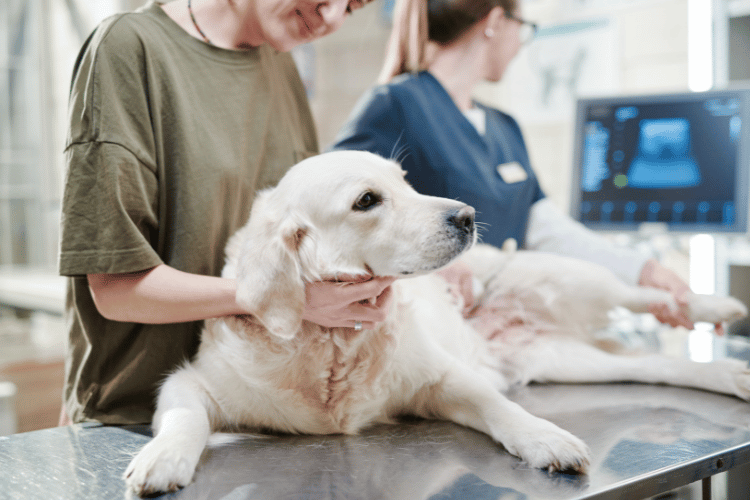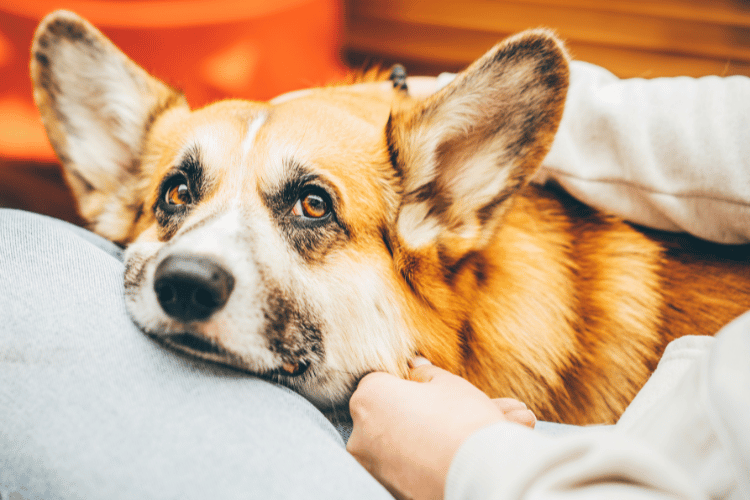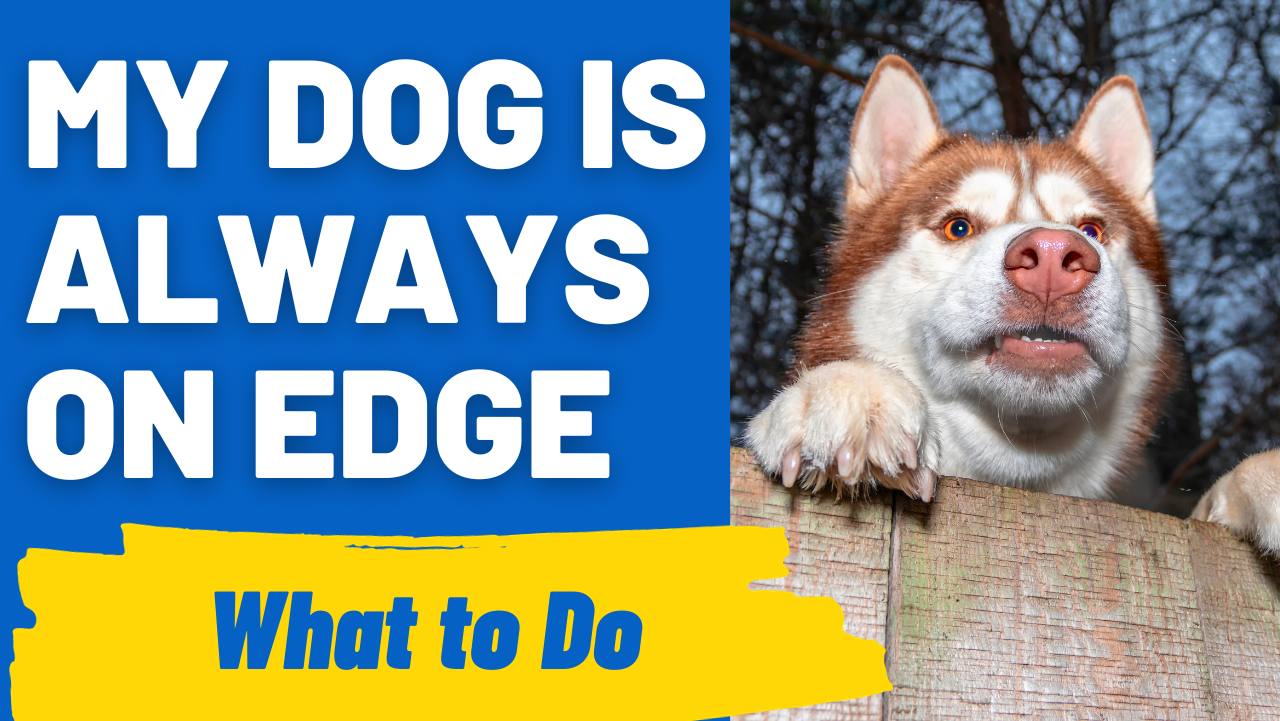Your canine friend is acting off lately? Maybe refusing to eat, pacing around the house, or responding aggressively to things that didn’t bother him before.
It’s not uncommon for dogs to show weird behavior occasionally, but some behaviors are hard to ignore, such as pacing, excessive barking, and avoiding eye contact.
If your dog shows any of these signs, they might be dealing with stress or anxiety. As a proud dog owner, it’s crucial to recognize signs of stress in dogs and take steps to help them feel better.
In this post, we’ll review some of the most common indications your dog is on the edge. Also, we’ll share some tips on how to calm a stressed dog.
Why Is My Dog on Edge All the Time?
Dogs show weird behaviors from time to time, and it’s totally normal. However, if these signs persist and your dog is always on edge, they’re probably trying to tell you there’s something wrong.
Weird behavior varies among dogs, from staring into space to chasing their tails and scooting. That’s why detecting what’s wrong with your dog can be tricky.
But here are some possible reasons your dog is on edge all the time:
1. Injury or Illness
Dogs always act weird when they’re in pain. They might sleep more than usual, look lethargic, become anti-social, or growl consistently.
If that’s the case, your dog is simply trying to tell you they’re hurting. For instance, if your dog snaps or growls when you touch them, it can be a clear sign of injury or illness, and you should take them to the vet.
2. Hormonal Changes
Similar to humans, dogs undergo hormonal imbalances throughout their life. If your dog is pregnant or becoming sexually mature, it’s normal for them to start showing odd behavior due to hormonal changes.
That includes nesting, aggression, humping, and panting. While these behaviors are normal during hormonal changes, it’s crucial to consult a vet if your dog shows them persistently.
3. Stress
Since dogs are creatures of habit, they can get stressed out too easily. Even a slight disruption to their routine can cause them to become nervous and anxious.
When under stress, dogs hide, have indoor accidents, or refuse to eat. This usually happens when you leave your dog home alone for a long time, move to a new home, or have a lot of unfamiliar people around.
4. Fear
Fear is another common reason for your dog’s odd behavior. When dogs feel scared, they tend to hide, yelp, defecate, and become more aggressive. This behavior is often temporary, and your dog should act normal again once it feels safe.
However, if your dog has been through a traumatic event, it may develop chronic fear and anxiety. In this case, the odd behavior will likely persist for a long time, and you might need to seek professional help from a qualified trainer or animal behaviorist.
What Are the Signs of Stress in a Dog?

Canine stress is a complex issue, and it’s essential to understand the different signs of stress in dogs so you can act accordingly. If dog stress is left unchecked, it can lead to serious problems such as destructive behavior and aggression.
Here are some obvious signs of stress in dogs:
- Yawning
- Lip licking
- Dilated pupils or redness around the eyes
- Consistent pacing back and forth
- Trembling
- Avoiding eye contact
- Whimpering or whining
- Tucking tail
- Avoiding interaction
Other signs your dog might be under stress are the following:
- Changes in eating and drinking habits: A stressed dog will eat less or more than usual.
- Changes in body functions: Frequent bowel movements, diarrhea, and vomiting can all be signs of stress.
- Behavioral changes: Such as withdrawal, clinginess, and increased aggression.
- Shivering and trembling: While not feeling cold or excited.
- Compulsive behaviors: Like constant chewing, licking, and barking. These habits are usually a way for dogs to soothe themselves.
- Changes in body language: Freezing in place, growling, and avoiding eye contact can be a sign your dog is anxious.
The key to recognizing signs of stress in your dog is to monitor their daily habits and body language. That way, you can quickly identify the cause of their stress and take the appropriate action.
Why Is My Dog Pacing and Won’t Settle?
Seeing your dog pacing constantly can be worrisome, especially for first-time dog owners. Still, pacing from time to time is a common behavior among canines.
Your dog might be pacing because they’re stressed, anxious, excited, or bored. They might also be alerting you as they can detect bed bugs, rodents, and pests in the walls of your home.
But if your dog never calms down, there could be a serious physical or mental health issue that needs to be addressed.
Let’s take a closer look at the common reasons for dog pacing:
1. Excitement
It’s normal for dogs to pace around back and forth when they’re excited. For example, when you leave home and return, you might notice your dog running around everywhere.
This is their way of showing you they’re happy to see you. They might also be waiting for food, treats, walks, and attention.
2. Stress/ Anxiety
As we mentioned, dogs become stressed for various reasons, such as fear of loud noises, separation anxiety, and changes in their daily routine. When stressed, dogs tend to pace, bark, and even become destructive.
3. Pain

If your dog is pacing all the time, they might be experiencing physical pain. Dogs might pace around for too long when they’re in pain simply because they can’t find comfort sitting or lying down.
4. Threat
Since dogs have an extremely strong sense of smell, they detect the presence of strangers and other dogs in their territory.
If you invited a guest over, you might notice your dog pacing around the house and barking at the door before your friend knocks. While guests are harmless, dogs often perceive them as intruders and may act aggressively towards them.
5. Lack of Exercise
Regular exercise is crucial for dogs to stay calm and healthy. If they don’t get their daily physical activity, they become restless and start pacing around the house.
6. Boredom
Dogs are notorious for being active and intelligent, so they need daily physical and mental stimulation to stay active and healthy.
When dogs don’t get plenty of walks, playtime, and interactive activities, they get bored and start pacing around.
Is My Dog Stressed or Just Excited?
Did you know dogs exhibit similar actions when stressed and excited? For example, dogs may pace around and bark excessively when excited. They might also behave similarly when they’re in pain or stressed.
Sometimes, it’s challenging to tell if your dog is stressed or excited, especially if you’re a novice dog owner. However, by carefully watching your dog’s habits and behaviors, you can detect when something is wrong, and your dog is just too happy.
To tell whether your dog is stressed or excited, here are some signs to look for:
1. Vocalization
Stressed and excited dogs are usually vocal, but the sounds may be different. For example, growling is often a sign of stress. Canines growl when they feel afraid, threatened, and in pain.
On the other hand, dogs bark excessively when excited or stressed. The difference is that excited dogs usually have a happy, high-pitched bark, while stressed dogs have a low-pitched bark that sounds more like growling.
2. Body Language
Watching your dog’s body signs is an excellent way to determine what’s wrong with them, as they show distinctive signs when experiencing stress or excitement. For instance, stressed dogs usually display tense body language.
They might yawn excessively, lick their lips, or tuck their tail between their legs. Conversely, excited dogs usually have a wagging tail and a more relaxed body language. Their ears are also in a forward neutral position.
3. Behavior
Stressed dogs often become anti-social and have difficulties interacting with other dogs and humans. In other words, they try to remove themselves from the stressful situation. Meanwhile, excited dogs are usually eager to engage, play, and interact with others.
4. Environment
Use your common sense to determine what might be causing your dog to act in a particular way. For example, in the presence of guests or new pets, your dog might get stressed and act odd.
On the other hand, when it’s time for a meal or a walk, your pup will get excited and act impatiently.
How Do You Calm an Overstimulated, Stressed, and On-Edge Dog?

When calming a stressed dog, it’s vital to detect and remove the stress triggers immediately.
In case you don’t know what’s exactly stressing your dog, here are some techniques to calm an overstimulated dog:
- Craft and stick to a consistent schedule, as even minor changes in dog routine lead to stress.
- Try white noise or music to provide a calming environment for your stressed pooch.
- Regular exercise and mental stimulation can tire your dog mentally and reduce stress.
- Desensitization and over-conditioning techniques.
- Regular grooming, such as brushing your dog’s coat, can promote relaxation by stimulating the release of endorphins.
- Thundershirts help dogs stay relaxed during stressful conditions by applying gentle pressure on their bodies.
- Opt for calming products such as pheromones.
What Dog Breeds Have the Most Anxiety?
Even though all dogs are prone to stress and anxiety, some breeds are more likely to have anxiety problems. Here are some of the most anxious dog breeds:
- Toy poodle
- Cavalier King Charles Spaniel
- Border Collie
- German Shorthaired Pointer
- Bichon Frise
- Australian Shepherd
- Labrador Retriever
- Lagotto Romagnolo
- Cocker Spaniel
- Jack Russell Terrier
To Wrap Up
There you have it; everything you need to know about calming a stressed dog. Remember that every dog is different, and dogs get stressed for a plethora of reasons.
So, if you think the mentioned stress signs apply to your dog, follow the suggested tips to calm your anxious pup.




